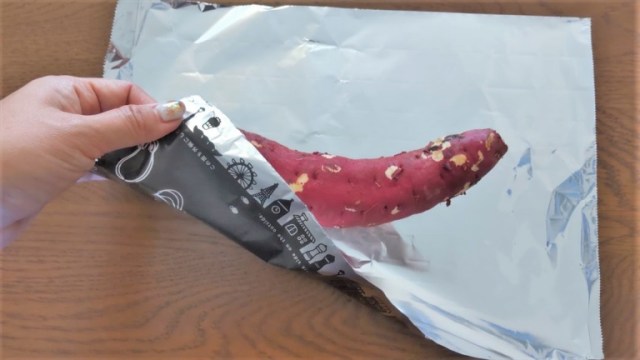
Kuro Foil is exactly the kind of culinary black magic we want at this time of year.
One of Japan’s favorite snacks at this time of year is yaki-imo, roasted sweet potatoes. These spuds are at their most scrumptious when you can minimize the time between roasting them and taking your first bite, and the best way to do that is by roasting them yourself at home.
So on our last trip to the grocery store, we picked up a pair of sweet potatoes to cook up, and also a pack of a special kind of Japanese aluminum foil that its makers say will make your sweet potatoes taste extra delicious.
Made by Osaka-based Toyo Aluminum Ekco Products Co., it’s called Ishiyaki-imo Kuro Foil. Kuro is the Japanese word for “black,” and sure enough, one side of this sweet potato-oriented foil is primarily black in color.
As luck would have it, we also happened to have a roll of regular Toyo Aluminum Ekco on hand. Aside from the color, we couldn’t tell any difference between the two. Both felt the same to the touch, and according to their packaging they have an identical thickness of 11 micrometers (0.00043 inches).
▼ The special yaki-imo foil (left) and the regular kind (right)
However, the packaging for Ishiyaki-imo Kuro Foil has a chart that claims the black foil heats the sweet potatoes’ core more quickly and to a higher temperature.
▼ Kuro Foil (red line) vs, regular foil (blue line)
Temperature in Celsius on the vertical axis and minutes in the oven on the horizontal
To test that claim, we wrapped one sweet potato in each kind of foil and popped them in the toaster oven at 1,000 kilowatts for 20 minutes.
▼ We wrapped them tightly, making sure there were no gaps for heat to leak out of during cooking.
Then we left them roast for 20 minutes. After we pulled them out, we started with a check of the regular foil-roasted sweet potato, and…
…we were immediately disappointed. The potato pulled apart with a loud “SNAP!”, and it didn’t look or smell much different from a raw sweet potato. This shouldn’t be taken as a mark against the quality of Toyo Aluminum Ekco’s normal aluminum foil, though, but against the quality of our pre-cooking preparations. The temperature comparison chart on the Kuro Foil package has “10 minutes” marked near its center, so we’d just sort of assumed 20 minutes is how long you’re supposed to roast sweet potatoes for. It turns out, though, that if you’re starting with a raw sweet potato, you’re supposed to give it a full hour in the oven.
With that revelation, we figured the Black Foil sweet potato wasn’t going to have come out any better, since it too had only been cooked for a third of the recommended time. So imagine our surprise when…
…instead of snapping, the two halves pulled smoothly apart, revealing a fluffy, fragrant yaki-imo!
▼ Regular foil (left) vs. Kuro Foil (right)
Amazingly, the Kuro Foil sweet potato had roasted all the way to the core, allowing its natural sugars to caramelize and rewarding us with a moist, sweet, and quickly-devoured yaki-imo.
By the way, you might have noticed that the Kuro Foil’s packaging includes an extra mo (も) character.
Though it’s not part of the official name, Toyo Aluminum Ekco added this additional mo, meaning “also,” as a reminder that while yaki-imo are the reason the product was developed, it can also be used for better roasting of other foods like eggplant, mushrooms, and onions.
We should point out that Ishiyaki-imo Kuro Foil isn’t particularly cheap. Our 4.6-meter (15.1-foot) roll cost us 360 yen (US$2.60), which isn’t itself a cost-prohibitive price, but it still quite a bit more than you’d pay for that amount of normal foil in Japan. Still, it really does seem to work as advertised, with its more efficient cooking working like a time machine that let us enjoy our yaki-imo much sooner than regular foil would.
Photos ©SoraNews24
● Want to hear about SoraNews24’s latest articles as soon as they’re published? Follow us on Facebook and Twitter!
[ Read in Japanese ]